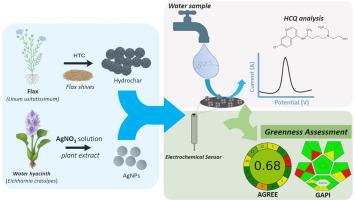Renewable carbon from flax shives with silver nanoparticles biosynthesized using Eichhornia crassipes extract for green electrochemical detection of hydroxychloroquine
IF 3.7
Q1 CHEMISTRY, ANALYTICAL
引用次数: 0
Abstract
Hydroxychloroquine (HCQ) is an antimalarial drug that was repurposed during the COVID-19 pandemic. However, due to its limited clinical efficacy and notable side effects, its recommendation was later withdrawn. Despite this, HCQ sales increased by over 800 % in Brazil, and its presence has since been detected in aquatic environments, raising concerns regarding potential risks to both environmental and human health. In response, a novel green electrochemical sensor was developed for the determination of HCQ in water samples. The sensor is based on a glassy carbon electrode modified with hydrochar derived from flax shives and silver nanoparticles biosynthesized using Eichhornia crassipes (water hyacinth) extract as a reducing and stabilizing agent (GC/HC-AgNPs). The sensor was characterized by scanning electron microscopy (SEM), energy-dispersive X-ray spectroscopy (EDS), and cyclic voltammetry (CV). Experimental parameters were optimized, and the device was successfully applied for the detection of HCQ using differential pulse voltammetry (DPV). The sensor exhibited a linear response in the range of 1.0–40.0 µmol L⁻¹, with a limit of detection (LOD) of 0.265 µmol L⁻¹ and a limit of quantification (LOQ) of 0.885 µmol L⁻¹. Excellent repeatability (RSD = 2.27 %) and reproducibility (RSD = 5.75 %) were achieved. Application in tap and lake water samples resulted in recovery values ranging from 89.5 % to 105.0 %, and comparative analysis with UV–vis spectroscopy confirmed the accuracy of the proposed method. The sensor further demonstrated good selectivity even in the presence of relevant interfering species. Green chemistry assessment tools confirmed the sustainable character of the developed method. Overall, the proposed sensor represents a promising, effective, and environmentally friendly platform for HCQ monitoring in water matrices.

以亚麻籽提取物为原料合成可再生碳纳米银用于绿色电化学检测羟氯喹
羟氯喹(HCQ)是一种抗疟疾药物,在COVID-19大流行期间被重新利用。然而,由于其临床疗效有限,副作用明显,后来撤销了推荐。尽管如此,HCQ在巴西的销量增长了800%以上,此后在水生环境中发现了HCQ的存在,引发了人们对环境和人类健康潜在风险的担忧。为此,研制了一种新型绿色电化学传感器,用于水样中HCQ的测定。该传感器基于一种玻璃碳电极,该电极由亚麻屑中提取的碳氢化合物修饰,而银纳米粒子是用水葫芦提取物作为还原剂和稳定剂(GC/HC-AgNPs)生物合成的。采用扫描电子显微镜(SEM)、能量色散x射线能谱(EDS)和循环伏安法(CV)对传感器进行了表征。对实验参数进行了优化,成功地将该装置应用于差分脉冲伏安法(DPV)检测HCQ。该传感器在1.0-40.0µmol L⁻¹范围内呈线性反应,检测限为0.265µmol L⁻¹,定量限为0.885µmol L⁻¹。重复性好(RSD = 2.27%),重现性好(RSD = 5.75%)。应用于自来水和湖泊水样,回收率为89.5% ~ 105.0%,与紫外-可见光谱对比分析证实了该方法的准确性。该传感器在相关干扰物质存在的情况下也表现出良好的选择性。绿色化学评价工具证实了所开发方法的可持续性。总的来说,所提出的传感器代表了一个有前途的、有效的、环保的平台,用于监测水基质中的HCQ。
本文章由计算机程序翻译,如有差异,请以英文原文为准。
求助全文
约1分钟内获得全文
求助全文

 求助内容:
求助内容: 应助结果提醒方式:
应助结果提醒方式:


